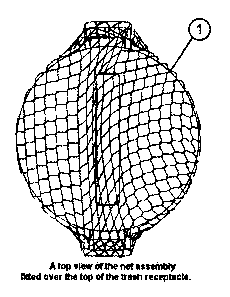Some of the information on this Web page has been provided by external sources. The Government of Canada is not responsible for the accuracy, reliability or currency of the information supplied by external sources. Users wishing to rely upon this information should consult directly with the source of the information. Content provided by external sources is not subject to official languages, privacy and accessibility requirements.
Any discrepancies in the text and image of the Claims and Abstract are due to differing posting times. Text of the Claims and Abstract are posted:
| (12) Patent Application: | (11) CA 2627207 |
|---|---|
| (54) English Title: | A LOCKING NET FOR GARBAGE CONTAINERS TO PREVENT ANIMAL ENTRY |
| (54) French Title: | FILET DE CONTENTION EMPECHANT LES ANIMAUX D'ACCEDER AU CONTENU DES POUBELLES |
| Status: | Deemed Abandoned and Beyond the Period of Reinstatement - Pending Response to Notice of Disregarded Communication |
| (51) International Patent Classification (IPC): |
|
|---|---|
| (72) Inventors : |
|
| (73) Owners : |
|
| (71) Applicants : |
|
| (74) Agent: | |
| (74) Associate agent: | |
| (45) Issued: | |
| (22) Filed Date: | 2008-03-17 |
| (41) Open to Public Inspection: | 2009-09-17 |
| Availability of licence: | N/A |
| Dedicated to the Public: | N/A |
| (25) Language of filing: | English |
| Patent Cooperation Treaty (PCT): | No |
|---|
| (30) Application Priority Data: | None |
|---|
This application describes a garbage or trash can lid securing assembly to
secure a garbage can lid against removal by animals such as raccoons, the
garbage can assembly comprising: a flexible net fitted with a securing strap
enclosing a bungee cord tightened by an adjustable draw cord closure
mechanism to fit the net securely to a variety of different trash receptacles.
Note: Claims are shown in the official language in which they were submitted.
Note: Descriptions are shown in the official language in which they were submitted.

2024-08-01:As part of the Next Generation Patents (NGP) transition, the Canadian Patents Database (CPD) now contains a more detailed Event History, which replicates the Event Log of our new back-office solution.
Please note that "Inactive:" events refers to events no longer in use in our new back-office solution.
For a clearer understanding of the status of the application/patent presented on this page, the site Disclaimer , as well as the definitions for Patent , Event History , Maintenance Fee and Payment History should be consulted.
| Description | Date |
|---|---|
| Application Not Reinstated by Deadline | 2012-03-19 |
| Time Limit for Reversal Expired | 2012-03-19 |
| Deemed Abandoned - Failure to Respond to Maintenance Fee Notice | 2011-03-17 |
| Inactive: Cover page published | 2009-10-02 |
| Application Published (Open to Public Inspection) | 2009-09-17 |
| Inactive: Payment - Insufficient fee | 2009-06-19 |
| Inactive: Correspondence - Formalities | 2009-06-17 |
| Inactive: First IPC assigned | 2008-10-16 |
| Inactive: IPC assigned | 2008-10-16 |
| Filing Requirements Determined Compliant | 2008-05-14 |
| Inactive: Filing certificate - No RFE (English) | 2008-05-14 |
| Application Received - Regular National | 2008-05-14 |
| Small Entity Declaration Determined Compliant | 2008-04-21 |
| Abandonment Date | Reason | Reinstatement Date |
|---|---|---|
| 2011-03-17 |
The last payment was received on 2010-03-17
Note : If the full payment has not been received on or before the date indicated, a further fee may be required which may be one of the following
Please refer to the CIPO Patent Fees web page to see all current fee amounts.
| Fee Type | Anniversary Year | Due Date | Paid Date |
|---|---|---|---|
| Application fee - standard | 2008-03-17 | ||
| MF (application, 2nd anniv.) - small | 02 | 2010-03-17 | 2010-03-17 |
Note: Records showing the ownership history in alphabetical order.
| Current Owners on Record |
|---|
| GEORGE BOGOJEVIC |
| Past Owners on Record |
|---|
| None |